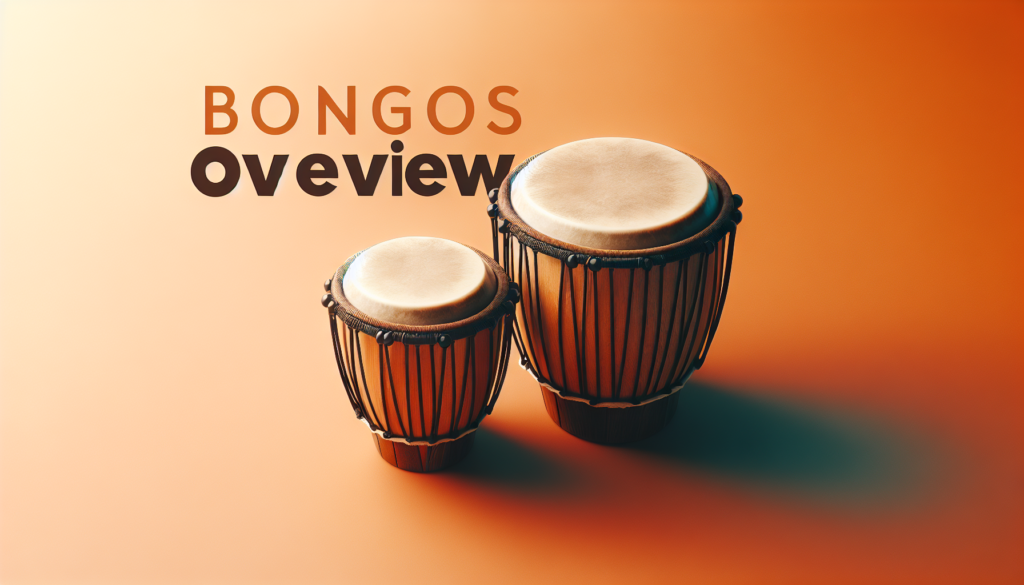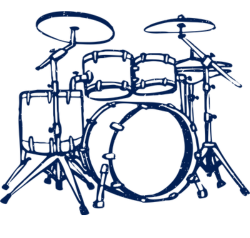
1. What Are Bongos? An Overview of the Traditional Percussion Instrument
Bongos are a traditional percussion instrument originating from Cuba. They are two small drums that are joined together and played with the hands. The larger of the two drums is called the hembra, or female drum, and the smaller is called the macho, or male drum. The drums are usually made of wood and covered with skin, although other materials such as metal and plastic are also used.
Bongos are an important part of Cuban music and have been used for centuries. The bongo is used in a variety of genres, including salsa, merengue, rumba, and son. The instrument is usually used to provide a rhythmic accompaniment to the other instruments, but can also be used to provide solo melodies.
Bongo Drumming Technique
Bongo drumming is a complex skill that requires practice and patience. The technique involves striking the drums with the hands in a variety of ways. The player must be able to produce different tones and rhythms by using various combinations of hand movements. The most common technique is called the tumbao, which involves alternating between the hembra and the macho.
Bongo Players
Bongo players are highly respected in the world of music. Many famous musicians have played the bongos, including Desi Arnaz, Mongo Santamaria, and Carlos “Patato” Valdes. The bongo is an essential part of Latin American music and can be heard in many different genres.
Bongo players are often part of larger bands or ensembles, but can also be featured as soloists. Bongo players must have a deep understanding of rhythm and an ability to improvise. They must also be able to keep a steady tempo and maintain the energy of the music.
2. The History of Bongos: A Look at the Origins of the Popular Instrument
The bongo is a popular percussion instrument used in many musical genres around the world, including salsa, jazz, and rock. Its roots can be traced back to African and Latin American cultures, and it has been a staple in many music styles since its introduction to the world. Here is a look at the history of the bongo and its evolution over time.
Early Origins of the Bongo
The bongo is believed to have originated in Africa and was brought to Latin America by African slaves. The instrument was adopted by the Cuban culture in the 19th century and has been a popular instrument in Latin American music ever since. The traditional bongo consists of two drums of different sizes, typically made of wood or metal, and can be played with hands or sticks.
Popularization of the Bongo
In the early 20th century, the bongo began to gain international popularity, thanks to its incorporation into jazz music by artists like Chano Pozo and Mongo Santamaria. The instrument also gained popularity in other genres, such as salsa, rock, and reggae. By the mid-20th century, the bongo was a well-known instrument in many musical genres.
Modern Bongo Styles and Variations
Today, the bongo is still widely used in many different musical styles, from jazz to salsa to rock. There are also many different variations of the bongo, such as the conga, timbale, and cajon. These variations are often used to add unique sounds and rhythms to a song. In addition, there are many different techniques used to play the bongo, such as slap, mambo, and flam.
The bongo has come a long way since its early origins, and it continues to be a popular instrument in many different musical styles. Its unique sound and versatility have made it a favorite among musicians and listeners alike.
3. Exploring the Different Types of Bongos and Their Uses
Bongos are a popular and versatile percussion instrument, often seen in Latin music, jazz, and other genres. There are several different types of bongos, each with its own distinct sound and uses. From the traditional African style to the modern Cuban-style bongos, this article explores the various types of bongos and their uses.
African Bongos
The traditional African bongos are often referred to as the “talking drums” due to their ability to imitate the sound of human speech. These bongos have two small drums connected together by a single piece of rope. The drums are made from hollowed out wood and covered with animal skin, typically goat skin. The traditional African bongos are played with sticks, and the tone of the drums can be altered by pressing the fingers onto the skin. African bongos are used to accompany traditional African music and storytelling.
Cuban Bongos
The Cuban bongos are the most commonly seen type of bongos. They are made up of two drums connected together, one larger than the other. They are typically made from wood and covered with a thin layer of plastic. The Cuban bongos are played with the hands and fingers, creating a distinct Latin sound. Cuban bongos are often seen in Latin music and salsa bands, and they can be used to create a variety of different rhythms.
Tumbadoras
Tumbadoras are a type of bongo that originated in Cuba. They are made up of two drums of the same size, connected together by a single piece of rope. The drums are made from wood and covered with animal skin, usually goat skin. The tumbadoras are played with the hands and fingers, creating a distinct Latin sound. Tumbadoras are often used in Latin music and salsa bands, and they can be used to create a variety of different rhythms.
Cajones
Cajones are a type of bongo that originated in Peru. They are made up of two drums of the same size, connected together by a single piece of rope. The drums are typically made from wood and covered with a thin layer of plastic. The cajones are played with the hands and fingers, creating a unique and powerful sound. Cajones are often used in Latin music and flamenco bands, and they can be used to create a variety of different rhythms.
4. How to Play the Bongos: A Guide for Beginners
Learning how to play the bongos is an exciting journey. Whether you’re looking to learn the basics or develop advanced skills, this guide is the perfect resource for beginners to learn how to play the bongos.
1. Get Familiar with the Bongos
The first step to learning how to play the bongos is to get familiar with the instrument. The bongos are a pair of small drums, usually made from wood, and connected by a rope. The drums are open at the bottom and closed at the top, which gives them their distinct sound. The larger drum is called the hembra, and the smaller drum is called the macho.
2. Learn the Basic Techniques
Now that you’re familiar with the instrument, it’s time to learn the basic techniques. The most basic technique is called the palo. This technique involves striking the hembra and macho drums in alternating patterns. You can also use your fingers to produce different sounds and rhythms.
3. Practice and Play Along with Music
Once you’ve mastered the basics, it’s time to practice and play along with music. Start with simple songs and progress to more complex rhythms. You can also practice solo to get more comfortable with the instrument. As you practice, listen to the sound of the bongos and try to replicate it.
4. Take Bongo Lessons
If you want to take your skills to the next level, consider taking bongo lessons. Professional bongo players can teach you more advanced techniques and help you develop your skills. With the help of a teacher, you can become an expert bongo player in no time.
5. Bongos in Popular Music: An Analysis of the Instrument’s Influence
The bongo is a small two-headed drum of African origin, and is a popular instrument in Latin music. Its unique sound has been influential in a variety of musical genres, from jazz to reggae to rock. Here, we will explore the bongo’s impact on popular music and analyze how its distinctive sound has been embraced by artists of different styles.
Latin Music
The bongo has been a staple in Latin music since the early 20th century. It has been a central component of mambo, cha-cha, salsa, and other forms of Latin music, providing the upbeat rhythm and percussion that gives the music its signature flavor. The bongo’s quick, staccato sound has been an integral part of these genres, helping to create the vibrant energy that Latin music is known for.
Jazz
The bongo has also been embraced by jazz musicians, who have incorporated it into their compositions to provide a more Latin-infused sound. Artists such as Dizzy Gillespie and Tito Puente used the bongo to great effect in their jazz pieces, creating a unique blend of jazz and Latin music. Bongos can also be heard in the works of modern jazz musicians, including John Coltrane, Herbie Hancock, and Chick Corea.
Reggae and Ska
The bongo has also been an important part of reggae and ska music. The distinctive sound of the bongo helps to create the unique reggae groove, providing the laid-back, skankin’ beat that is a hallmark of these genres. Artists such as Bob Marley, Toots and the Maytals, and Desmond Dekker have all featured the bongo prominently in their music.
Rock Music
The bongo’s influence has even extended to rock music. The instrument has been used by bands such as The Beatles, The Rolling Stones, and Led Zeppelin to add a Latin flavor to their songs. Additionally, the bongo has been a key component of the Latin-infused rock of Santana, helping to create the signature sound of the band.
The bongo is a versatile and unique instrument that has been embraced by a variety of musical styles. From Latin music to jazz to reggae to rock, the bongo’s distinctive sound has been influential in shaping popular music for decades.
6. Shopping for Bongos: Tips for Finding the Right Instrument for You
Whether you’re just starting out as a musician or you’re an experienced drummer, you’ll need to know how to shop for bongos. Bongos are an essential part of many Latin American musical styles, and they can be a great addition to any drummer’s arsenal. To help you find the right instrument for you, here are some tips for shopping for bongos.
Choose the Right Size
When it comes to shopping for bongos, the size of the instrument is important. Generally speaking, the larger the bongos, the deeper the sound they produce. If you’re looking for a bongo to play in a larger ensemble, you’ll want to opt for a larger size. If you’re looking for a bongo to play in a smaller ensemble or as a solo instrument, you’ll want to opt for a smaller size.
Choose the Right Material
Another important factor to consider when shopping for bongos is the material. Bongos can be made from a variety of materials, including wood, metal, and plastic. Each material has its own unique sound, so it’s important to choose the right material for your needs. Generally speaking, wood bongos produce a warmer sound, while metal and plastic bongos produce a brighter sound.
Choose the Right Head Type
When shopping for bongos, you’ll also want to consider the type of head. The head is the part of the bongo that produces the sound. Bongos can have either a natural skin head or a synthetic head. Natural skin heads produce a warmer sound, while synthetic heads produce a brighter sound.
Test Before You Buy
Finally, it’s important to test the bongos before you buy them. Every bongo is unique, and it’s important to find one that produces the sound you’re looking for. You can test bongos in a store or online, but it’s always best to test them in person if possible. This will give you the best idea of how the bongos sound and feel.
